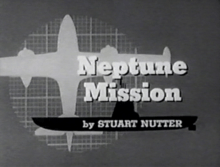Neptune Mission
Neptune Mission (also known as Neptune's Mission) is a 1958 30-minute Canadian short documentary film produced by the National Film Board of Canada (NFB) for the Canadian Broadcasting Corporation (CBC) television series, Perspective.[2][Note 1] The film documents the submarine-hunting mission of the RCAF Neptune aircraft on Canada's Atlantic coastline during the Cold War. Neptune Mission is produced by David Bairstow, and directed by Walford Hewitson.[3]
| Neptune Mission | |
|---|---|
 Title frame | |
| Directed by | Walford Hewitson |
| Produced by | David Bairstow |
| Written by | Stuart Nutter |
| Narrated by | Budd Knapp |
| Cinematography |
|
| Edited by |
|
Production company | |
| Distributed by |
|
Release date |
|
Running time | 30 minutes |
| Country | Canada |
| Language | English |
Synopsis
During the Second World War, from its Halifax, Nova Scotia headquarters, the Royal Canadian Air Force PBY Canso aircraft, along with the Royal Canadian Navy (RCN), were heavily involved in anti-submarine warfare (ASW) directed against Nazi U-boat attacks on convoy and coastal shipping. In postwar operations, building on the success of its wartime missions, the RCAF continued to maintain anti-submarine capability from their Greenwood, Nova Scotia base.
In 1958, during the Cold War, the threat of Soviet nuclear-powered submarines led the RCAF to acquire Lockheed P2V7 Neptune aircraft. The advent of airborne radar, sonar and magnetic anomaly detection (MAD)-equipped aircraft such as the Neptune, made for a potent counter. The armament on the P2V7 included two torpedoes, mines, depth charges, bombs carried internally plus unguided rockets mounted externally underwing.
On annual North Atlantic Treaty Organization (NATO) exercises, the RCAF Neptune crews worked closely with naval forces from both Canada and the United States, and through joint operations, continued to train for operational readiness. On a typical training mission, an RCAF crew will receive instructions from its Halifax headquarters, and fly in a combined aerial and naval mission using airborne MAD/sonobuoy equipment to detect a submarine attempting to penetrate the naval forces protecting a high value target such as a convoy or aircraft carrier task force.
In the 1958 Delta 54 training exercise, an RCAF Neptune (VN-123) flies a precise pattern over the Atlantic Ocean when a radar contact of a "spook" is made.[Note 2] Two destroyers take up the chase, leaving the task force and joining Neptune VN-123. Using sonobuoys, the Neptune relays an exact location of the contact to the destroyers that take up station over the suspected submerged enemy submarine, now forced to either escape or curtail its threat to the task force. The exercise concludes with another RCAF Neptune relieving VN-123 to return to its base in Nova Scotia.
.jpg)
Production
Neptune Mission was part of the NFB's series of documentary short films for the CBC TV series Perspective that ran from 1956–58.[6] Each half-hour program, produced by the National Film Board included both documentaries and dramatic productions. Most episodes concerned contemporary issues in Canada, although several involved international incidents or topics such as life in Haiti. A small number of the Perspective series were historical reconstructions. Generals Wolfe and Montcalm at the Battle of the Plains of Abraham was one example.[3]
A close working relationship with the RCAF and the RCN allowed the NFB to chronicle the operational use of the Neptune. The aircrew of VN-123 played their parts as themselves, while the aircraft went through its operational mission from headquarters planning, crew walkabout, surveillance training to successful completion of the NATO exercise. The aerial sequences by NFB cinematographers Peter Kelly and Reginald Morris, along with sound engineer Don Wellington. included footage shot from accompanying aircraft and naval vessels, as well as from inside the Neptune as it went through its training mission.[5]
Reception
Neptune Mission was primarily made-for-television, but after broadcast on March 2, 1958, with a re-broadcast on May 25, 1958 as Neptune's Mission on the CBC, the film was made available on 16 mm to schools, libraries and other interested parties.[1] The film was also made available to film libraries operated by university and provincial authorities. Excerpts from Neptune Mission appeared in other NFB productions, including The Golden Age (1959).[7]
References
Notes
- The introduction of the Lockheed Neptune into service with the Royal Canadian Air Force (RCAF) was featured in an earlier 1955 NFB Eye Witness (No. 79) series segment entitled New Aircraft Joins Maritime Command, directed by Hector Lemieux.
- A "spook" in military terminology refers to a clandestine or secret operator/operation.[4]
Citations
- "Episode Guide- Perspective (Series) (1956-1958)." tvarchive.ca. Retrieved: February 20, 2016.
- Aitken 2013, p. 129.
- Ohayon, Albert. "Between fact and fiction: the NFB’s 1950s Perspective TV series." NFB, December 11, 2014. Retrieved: February 21, 2016.
- "Spook." Dictionary Central, 2016. Retrieved: February 21, 2016.
- Proc, Jerry. "The Canadian Neptune P2V7." jproc.ca, November 8, 2009. Retrieved: February 21, 2016.
- Ellis and McLane 2005, p. 152.
- "The Golden Age." NFB.ca. Retrieved: February 21, 2016.
Bibliography
- Aitken, Ian. The Concise Routledge Encyclopedia of the Documentary Film. London: Routledge, 2013. ISBN 978-0-4155-9642-8.
- Ellis, Jack C. and Betsy A. McLane. New History of Documentary Film. London: Continuum International Publishing Group, 2005. ISBN 0-8264-1750-7.